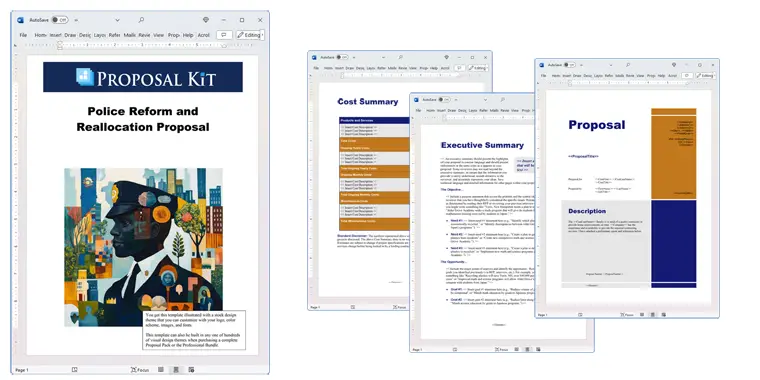How to write your Police Reform and Reallocation Proposal
We include this 26 page layout with every Proposal Pack. If you want this template to have a different visual design theme than the one illustrated here, purchase any Proposal Pack design and create this template using the purchased design theme. This template is included in every Proposal Pack. If you get a Proposal Pack or the Professional, you can also make any variation of this template with different chapters to suit your needs.
We typically include more chapters in the templates than most people will need to give everyone more variety in the chapters they may need. You can trim down a long template by removing pages you do not need or combining multiple chapter topics into one page.
 DOWNLOADABLE, ONE-TIME COST, NO SUBSCRIPTION FEES
DOWNLOADABLE, ONE-TIME COST, NO SUBSCRIPTION FEES If you need only this template pre-assembled on DVD media order from our Amazon shop.
If you need only this template pre-assembled on DVD media order from our Amazon shop.
You can also create countless variations of this document to suit your needs using the included library of 2200+ chapters if ordering a Proposal Pack or Professional.
 What Our Clients Say
What Our Clients SayI’ve been using Proposal Kit since 2018 now and helpful with completing proposals. It is highly recommended for small businesses. It’s user-friendly and integrated with the right tools."
HBD1 Consulting LLC
Related Article
Related Video
Related Templates
- Police Reform Program Proposal
- Community Action Report to Fight Police Abuse
- Interagency Training Center Proposal
- Safety Plan
- Security Plan
- Security Training and Consulting Services Proposal
- Safety Training and Consulting Services Proposal
- Security Tactical Training Proposal
- Security and Risk Analysis Project
- Security Survey, Analysis and Standard Compliance Proposal
- Safety Strategy and Training Program Proposal
- Gun Control Legislation Proposal
- Fighting Discrimination Funding Proposal
- Political Action Proposal
What's the best way to write your police reform and reallocation proposal?
Using the Proposal Kit template and software package is a proven solution for creating a detailed and effective police reform and reallocation proposal. The Proposal Kit's template library and Wizard software program provide a structured template and include a line item quoting database system. This system is important for creating detailed cost summaries, quotes, estimates, budgets, and other financial pages.
Are you tasked with writing a proposal to reform and restructure your local police department? If so, the Proposal Kit is designed for you.
What Types of Projects Are Police Reform and Reallocation Proposal Written For?
Police reform and reallocation proposals address a variety of projects aimed at improving the effectiveness and community integration of police forces. Here are some projects that proposals are written for:
- Developing community policing initiatives
- Implementing new training programs for sensitivity and bias
- Upgrading technology for improved data analysis
- Establishing crisis intervention teams
- Integrating mental health professionals into response units
- Reforming use-of-force policies
- Enhancing transparency and accountability measures
- Creating early warning systems for officer misconduct
- Building better relationships with community organizations
- Funding for body cameras and other monitoring tools
- Developing de-escalation training programs
- Improving dispatch systems for better resource allocation
- Setting up public oversight committees
- Conducting comprehensive audits and reviews of police practices
- Implementing restorative justice programs
- Redesigning recruitment and hiring processes
- Enhancing victim assistance services
- Organizing town hall meetings for community feedback
- Training on legal updates and civil rights awareness
- Establishing protocols for interacting with vulnerable populations
Chapters this template is built with
No one-size-fits-all template exists for police reform and reallocation proposals. Most likely, a custom template would have to be created. The Proposal Kit software allows users to create customized templates to fit any scenario, making it possible to address the specific needs of your project. Below is a selection of chapter templates from our extensive library that could be used:
Cover Letter
Introduce your proposal with a personalized cover letter that outlines your organization's commitment to police reform and how you plan to address the community's needs. This section should set the tone of the proposal, emphasizing your dedication to creating a police department that is more clear, accountable, and in alignment with the community's expectations.
Executive Summary
Summarize your proposal's key points, highlighting the significant goals and the impact expected from the reforms. This section is crucial as it provides a snapshot for stakeholders to quickly understand the essence of your proposal and the positive changes it aims to bring.
Goals and Objectives
Detail the specific goals and objectives your proposal aims to achieve, providing a clear roadmap for reform efforts. For instance, you can outline objectives like reducing police response times, increasing community engagement, and decreasing misconduct cases.
Benefits
Explain the benefits of your proposed reforms, focusing on improvements in community relations, efficiency, and accountability. Highlight how these benefits will create a safer and more trusting environment for officers and the community.
Funding Plan
This section outlines your financial needs and funding strategy, integrating detailed budget estimates from the Proposal Kit's quoting system. Specify potential funding sources, such as government grants or community fundraising, and demonstrate how funds will be allocated to various initiatives within the reform.
Transition Plan
Describe the steps you will take to implement the reforms, ensuring a smooth transition in policies and practices. This could include timelines for training, procurement of new equipment, and phased rollouts of new procedures.
Dispatching
Propose improvements to the dispatch system to ensure resources are appropriately allocated during police responses. This can involve integrating advanced technology for real-time tracking and communications to reduce response times and improve coordination.
Resource Allocation
Detail how resources, including personnel and technology, will be optimized under the new structure. For example, they are reallocating the budget from less critical areas to fund community outreach programs and advanced officer training.
Staffing
Discuss changes in staffing, including new positions or reassignments needed to support the reforms. This could include hiring specialists in mental health, community liaisons, or additional support staff to manage new technologies.
Risk Analysis
Evaluate potential risks associated with the reform process and propose mitigation strategies. Identify risks like resistance from within the department or the community and plan for measures like awareness campaigns and stakeholder engagement strategies.
Risk Management
Outline your strategies for managing identified risks throughout the implementation of the reforms. This might include regular risk assessment meetings, contingency plans, and protocols for addressing emerging challenges.
Responsibilities
Define the roles and responsibilities of all stakeholders involved in the reform process. Assign specific tasks to team members, outline the chain of command, and establish accountability measures to ensure everyone understands their role in achieving the project's goals.
Safety
Enhance safety protocols to protect both police officers and community members. Propose updates to current safety measures, such as increased training on de-escalation techniques and using non-lethal force options.
Security
Propose improvements in security measures as part of the reform process. This can involve adopting new technologies for data security, upgrading facilities, and implementing stricter protocols for evidence management.
Evaluation
Design a framework for evaluating the effectiveness of implemented reforms. Establish key performance indicators (KPIs) and metrics to measure the initiatives' success and schedule regular reviews to assess progress and make necessary adjustments.
Budget
Present a detailed budget incorporating all costs related to the reforms, supported by the Proposal Kit's financial tools. Break down expenditures into categories such as personnel, training, technology, and community programs to provide a clear view of the financial requirements.
Cost/Benefit Analysis
Provide a thorough cost/benefit analysis to justify the investment in police reform. Compare the costs of implementing the reforms against the anticipated benefits, such as reduced instances of misconduct, improved public trust, and lower crime rates.
Recommendations
Offer well-considered recommendations for stakeholders to support the successful implementation of the proposal. These include policy changes, additional funding, or collaborative efforts with community organizations.
Facilities
Discuss the infrastructural needs or improvements required to support the reforms. This could involve renovating police stations, creating community outreach centers, or upgrading training facilities to equip officers better.
Partnerships
Highlight potential partnerships with community organizations and other stakeholders. Emphasize the importance of collaboration with mental health professionals, social services, and local advocacy groups to address community needs holistically.
Social Responsibility
Emphasize the department's commitment to social responsibility and ethical policing. Outline initiatives that promote transparency, accountability, and community involvement, ensuring that reforms align with broader social justice goals.
Studies
Reference relevant studies or data that support the need for reform and the expected outcomes. Use empirical evidence to strengthen your proposal, citing successful reform efforts in other jurisdictions or academic research on best practices.
Lessons Learned
Share insights from other reform initiatives to inform best practices and avoid past mistakes. Discuss previous attempts at reform, what worked and didn't, and how those lessons have shaped your proposal to ensure its success.
Use cases for this template
Transforming Community Relations Through Effective Policing
The Challenge
John, a police chief in a mid-sized city, faced mounting criticism over the department's handling of community interactions. Public trust was eroding, and an increasing number of incidents involving police misconduct were capturing headlines and sparking community outrage. The community demanded significant changes, and John needed a comprehensive plan to restore faith in the police force.
The Solution
Realizing the gravity of the situation, John opted to use Proposal Kit to write a thorough and detailed proposal focused on community policing and transparency. The tool's extensive library of templates enabled him to create a multifaceted plan addressing various community concerns. The Proposal Kit allowed John to articulate strategies to increase community engagement, establish accountability measures, and enhance transparency within the department.
The Implementation
John customized the templates to include extensive community engagement plans, such as town hall meetings, and detailed new accountability measures, like public oversight committees and body cameras. He used the Proposal Kit's quoting tools to outline the financial topics, ensuring the proposal included a well-structured budget and cost/benefit analysis. The completed proposal was then presented to the city council.
The Outcome
The city council approved the proposal, impressed by its thoroughness and the clear plan for restoring trust between the police and the community. The department received increased funding to support community policing initiatives. Over time, public trust improved as the community witnessed tangible changes in police conduct and greater transparency in their operations.
Enhancing Response Capabilities with Advanced Dispatch Solutions
The Challenge
Emily, the communications director at a large metropolitan police department, was dealing with a significant issue: the department's outdated dispatch system. The antiquated technology led to delayed response times, misallocated resources, and frustration among officers and community members. The inefficiencies were becoming a serious impediment to providing timely and effective police services.
The Solution
Emily used Proposal Kit to write a state-of-the-art dispatch system upgrade proposal. The Proposal Kit's templates enabled her to outline a clear and compelling case for integrating AI technology and improved GPS tracking into the dispatch process. The proposal emphasized the need for modern technology to enhance real-time decision-making and resource allocation.
The Implementation
Emily detailed the phases of the new system's implementation in her proposal. She outlined the technical requirements, the procurement process, and staff training to operate the new system. Using the financial tools within the Proposal Kit, she provided a comprehensive budget and highlighted the long-term savings and operational efficiencies the new system would bring.
The Outcome
The proposal was approved, and the new dispatch system was successfully implemented. The upgrades led to significantly faster response times and more efficient resource allocation. Officers and community members alike noticed the improvements in service delivery, and the department was able to respond to emergencies more efficiently.
Building a Framework for Ongoing Police Education
The Challenge
Mark, a training coordinator at a suburban police department, identified a significant gap in ongoing education for police officers. The lack of continuous training and professional development led to outdated practices and insufficient skillsets among the officers. There was a pressing need for a structured program to keep the officers updated and well-trained in the latest policing techniques and community relations.
The Solution
Mark turned to Proposal Kit to develop a comprehensive proposal for a continuous education program. The Proposal Kit's library allowed him to create a proposal that included workshops, seminars, and partnerships with local universities. The goal was to provide officers with ongoing educational opportunities to continuously enhance their skills and knowledge.
The Implementation
Mark used the Proposal Kit to develop a detailed yearly curriculum that included mandatory and elective courses covering various policing topics. The proposal set benchmarks for officer participation and performance, ensuring the training program would be measured and evaluated regularly. He also outlined a budget, incorporating costs for instructors, materials, and partnerships with educational institutions.
The Outcome
The proposal was accepted, and the continuous education program was implemented. The program resulted in better-informed and more skilled officers better equipped to handle the complexities of modern policing. The community saw a noticeable improvement in police interactions and a renewed commitment to professional excellence within the department.
Conclusions and Recommendations
Proposal Kit can significantly simplify the process of writing a police reform and reallocation proposal. Proposal Kit provides all the tools necessary for a comprehensive and persuasive proposal, from addressing financial documentation with its integrated quoting database to customizing templates for various reform initiatives. Whether enhancing dispatch systems, improving community relations, or implementing new training programs, Proposal Kit helps you create a detailed, professional proposal tailored to your needs.
Also Known As
This template may also be referred to in different ways or be used in more specialized situations, such as:
- Police Department Restructuring Proposal
- Law Enforcement Reform Plan
- Community Policing Strategy Document
- Police Resource Reallocation Pitch
- Public Safety Improvement Proposal
- Police Training Enhancement Plan
- Emergency Response Optimization Proposal
- Law Enforcement Accountability Strategy
- Community-Led Policing Proposal
- Police Department Modernization Plan
Abstract
 In recent years, the call for police reform has gained significant traction, driven by public demand for accountability, transparency, and improved community relations. High-profile incidents of police violence have intensified scrutiny of law enforcement officers and agencies nationwide. This growing movement underscores the need for comprehensive change within municipal police departments, state law enforcement agencies, and federal government bodies. Key areas of focus include reducing officer-involved shootings, addressing racial disparities, and enhancing police-community trust.
In recent years, the call for police reform has gained significant traction, driven by public demand for accountability, transparency, and improved community relations. High-profile incidents of police violence have intensified scrutiny of law enforcement officers and agencies nationwide. This growing movement underscores the need for comprehensive change within municipal police departments, state law enforcement agencies, and federal government bodies. Key areas of focus include reducing officer-involved shootings, addressing racial disparities, and enhancing police-community trust.
Reforming the criminal justice system involves reallocating police budgets to fund mental health programs, implicit bias training, and other community-focused initiatives. Cities are exploring ways to integrate mental health services into police responses, supported by reallocated funds from police discipline and training budgets. The defund movement advocates for a shift in local government spending, emphasizing the importance of adequately funding programs that address root causes of crime, such as poverty and mental illness.
Law enforcement leaders and other government actors are redefining the role of police agencies by promoting procedural justice and reducing excessive force incidents. Training officers in de-escalation techniques and updating policies to minimize deadly force are critical steps in this transformation. Community groups and advocates continue to play an important role in pushing for major changes, including the establishment of public oversight committees and the implementation of restorative justice programs.
 The Proposal Kit offers a structured approach to creating police reform and reallocation proposals, allowing users to customize extensive template libraries and use automated line-item quoting for detailed financial planning. This tool aids in developing comprehensive strategies that address specific departmental needs, fostering collaboration among law enforcement agencies and community stakeholders. By using these resources, police leaders can articulate a clear vision for reform that aligns with public interest and enhances public safety.
The Proposal Kit offers a structured approach to creating police reform and reallocation proposals, allowing users to customize extensive template libraries and use automated line-item quoting for detailed financial planning. This tool aids in developing comprehensive strategies that address specific departmental needs, fostering collaboration among law enforcement agencies and community stakeholders. By using these resources, police leaders can articulate a clear vision for reform that aligns with public interest and enhances public safety.
The quest for police reform and reallocation is a dynamic response to ongoing concerns about police accountability and the effective allocation of police funding. High-profile cases have sparked rigorous debate and led to widespread Black Lives Matter protests across the country. These movements have called attention to the necessity of addressing police behavior and reducing officer-involved shootings through reforms that improve police-community relations and enhance training for officers. Proposals to defund the police do not necessarily reflect a desire to abolish law enforcement but rather to reallocate resources to community services and programs that can aid in reducing crime and solving violent crimes, such as mental health services and social workers.
Law enforcement agencies are actively responding to these calls for change by examining police culture and pitching measures that ensure adequate funding for community-based initiatives. This includes shifting resources towards better transparency, revising use-of-force policies, and fostering a police presence that collaborates with city residents. Cities are at the forefront of these efforts, exploring innovative solutions to over-policing and enhancing the relationship between police personnel and the communities they serve.
 The Proposal Kit provides a robust platform for creating police reform and reallocation proposals, offering the tools necessary to develop comprehensive plans that can be tailored to the unique needs of each municipality. By using Proposal Kit's automated line-item quoting and extensive template libraries, law enforcement leaders can articulate strategies that address systemic issues, improve disciplinary records, and support the recruitment of new officers with a focus on gender diversity and representation of black lives.
The Proposal Kit provides a robust platform for creating police reform and reallocation proposals, offering the tools necessary to develop comprehensive plans that can be tailored to the unique needs of each municipality. By using Proposal Kit's automated line-item quoting and extensive template libraries, law enforcement leaders can articulate strategies that address systemic issues, improve disciplinary records, and support the recruitment of new officers with a focus on gender diversity and representation of black lives.
As city residents and community groups continue to engage in dialogue with law enforcement, the importance of police accountability and the need for reform remain at the forefront. These conversations are shaping the future of American policing and ensuring that police departments across the nation can adapt to societal expectations and legislative changes. By fostering a culture of transparency and accountability, municipalities can create a safer environment for all citizens and maintain public trust in their law enforcement agencies.
The quest to revamp American policing through comprehensive reform and reallocation proposals is gaining momentum, catalyzed by the Black Lives Matter movement. These incidents have prompted societal introspection and highlighted the urgent need for systemic change within institutions. Addressing issues such as over-policing and reducing officer-involved shootings are central to these efforts, with a focus on developing new tactics to resolve incidents without escalating violence.
 The drive to defund the police is not a call to literally abolish law enforcement but rather a push to ensure resources are reallocated to social services that can better address underlying issues contributing to crime, such as gun violence and domestic violence. Progressive cities are exploring innovative approaches that involve more officers focused on community engagement and fewer dedicated solely to enforcement, a strategy that might also involve smaller departments.
The drive to defund the police is not a call to literally abolish law enforcement but rather a push to ensure resources are reallocated to social services that can better address underlying issues contributing to crime, such as gun violence and domestic violence. Progressive cities are exploring innovative approaches that involve more officers focused on community engagement and fewer dedicated solely to enforcement, a strategy that might also involve smaller departments.
The reform landscape is influenced by previous studies and findings, which indicate that departments with robust track records in community policing report improved outcomes in crime reduction and community trust. The introduction of state laws and executive orders aims to enforce accountability through measures like the national decertification index and the reevaluation of qualified immunity, ensuring that officers maintain a standard that aligns with public expectations.
Policymakers, activists, and community leaders are working collaboratively to write proposals that advocate for increased training for officers on issues like implicit bias and de-escalation techniques. These proposals also highlight the necessity for law enforcement agencies to receive adequate funding to assimilate these reforms without compromising public safety. The inclusion of more black-owned businesses in community initiatives further underscores the holistic approach required to foster long-lasting change.
 The Proposal Kit's role in facilitating these reforms cannot be understated. Providing a structured framework for writing detailed and customized proposals allows stakeholders to articulate solutions that address the complex dynamics of modern policing. This includes the integration of community feedback, the establishment of consent decrees, and the promotion of social justice initiatives, all of which are vital to navigating the intricate landscape of American law enforcement reform.
The Proposal Kit's role in facilitating these reforms cannot be understated. Providing a structured framework for writing detailed and customized proposals allows stakeholders to articulate solutions that address the complex dynamics of modern policing. This includes the integration of community feedback, the establishment of consent decrees, and the promotion of social justice initiatives, all of which are vital to navigating the intricate landscape of American law enforcement reform.
Frequently Asked Questions
What are the important components of a police reform and reallocation proposal?
Start with a cover letter to introduce the proposal and outline its purpose. Follow this with an executive summary highlighting the main points and the anticipated outcomes. Detailed sections on goals and objectives, benefits of the reforms, funding plans, and risk management strategies should also be included. Finally, it covers specifics like dispatching improvements, resource allocation, and community partnerships. Proposal Kit offers customizable templates to ensure each component is thoroughly addressed.
How do I demonstrate the need for police reform in my proposal?
Include data and case studies that highlight existing issues within the police department. This might involve statistics on response times, incidents of misconduct, or community feedback. Use the Proposal Kit's templates to create sections dedicated to these studies and lessons learned from other departments. Incorporating detailed risk analysis and evaluations of current practices can also make a strong case for why reform is necessary.
How can I outline the financial requirements for the reform?
Use the line item quoting database system provided by Proposal Kit to create accurate cost summaries, quotes, estimates, and budgets. Detail all financial topics, such as the costs of new equipment, additional training programs, and any new staffing requirements. A well-prepared budget and cost/benefit analysis will help stakeholders understand the financial implications and benefits of the proposed reforms.
What are some best practices for ensuring community support in my proposal?
In your police reform and reallocation proposal, dedicate sections to community engagement plans and partnerships. Proposal Kit templates can help you outline methods for involving community members, such as town hall meetings, surveys, and public oversight committees. To build trust and garner support, emphasize transparency, social responsibility, and the direct benefits of the reform to the community.
How can I customize the proposal to meet departmental needs?
Each police department has unique challenges and needs, so customization is critical. Proposal Kit offers an extensive library of thousands of templates to tailor to your specific situation. Whether you need to focus on dispatching improvements, new training programs, or policy changes, you can select and customize templates that address your particular requirements. This flexibility ensures that your police reform and reallocation proposal is comprehensive and highly relevant to your department's issues.
50% Off Discount
![]() Add To Cart This Word Template
Add To Cart This Word Template
 Add To Cart Proposal Pack for Any Business
Add To Cart Proposal Pack for Any Business
 Add To Cart Proposal Kit Professional
Add To Cart Proposal Kit Professional
 4.7 stars, based on 848 reviews
4.7 stars, based on 848 reviewsProposal Kit chapters used in this template
Cover Letter, Title Page, Table of Contents, Executive Summary, Goals and Objectives, Social Responsibility, Benefits, Transition Plan, Dispatching, Resource Allocation, Risk Analysis, Risk Management, Responsibilities, Safety, Security, Staffing, Facilities, Partnerships, Evaluation, Funding Plan, Budget, Cost/Benefit Analysis, Recommendations, Studies, Lessons Learned, Back Page
Line Item Automated Chapters
If you purchase a Proposal Pack or the Professional Bundle, these proposal pages are generated using an automated line-item database in the included Wizard software.
Budget Three Year, Cost Benefit Analysis
You use this proposal for
- General business proposal
- Education, training proposal
- Non-technical proposal
- RFP response
- State, county or local government grant proposal
- Security, safety, protection, investigation proposal
How to create this template with Proposal Pack Wizard
You can create this document using any of the logo-designed Proposal Packs. Pick any Proposal Pack with a logo design theme you like best; they will all work equally well. The Proposal Pack for Any Business is the pack with no extra added logos or colors - designed to be used plain or for you to customize with your logos and graphics.
The Proposal Pack design theme you purchase will determine the visual look of this template. The screenshot above only shows the plain generic design theme.
We include a library of chapters to be assembled based on your needs. All proposals are different and have different needs and goals. We designed Proposal Pack so you can customize the documents to suit your needs.
You will best create this document using the Proposal Pack Wizard - Expert Edition software to select this template and build it in the Proposal Pack logo design theme of your choice along with any desired customizations (such as adding additional chapters, removing unneeded chapters, changing the order of chapters, and importing your company logo). This template outlines a proposal for the described situation. Each user is responsible for typing in the actual content of the provided pages with their information to complete the proposal. Suggestions in the abstract may include features in higher-end packages and are facilitated by the selection of chapter templates to support the narrative of each proposal, which help guide the user in filling in the details.
The Wizard software's AI Writer will write the content of the pages of the template based on details provided for your company, client, project, financial details and other writing instructions. This will provide a personalized version of the template completely written and ready to edit.
Once finished, the AI Writer's Word-to-PowerPoint converter can transform your proposal, business plan, or other business documents into a PowerPoint slideshow. Save time and effort by letting the AI analyze every chapter to condense its content into talking points, visually matching the document, and providing a consistent package of presentation material with the click of a button.
You create this template using the Wizard software with an entire Proposal Pack library and software. We include the Expert Edition of the software in the Proposal Kit Professional. Microsoft Word for Windows is required to use the customizing software. You can also edit Word document templates in other office software such as Word for Mac. We will assist Mac users in assembling complex templates for their first project if they do not have the required platform to run the Wizard software.
How to Build Templates Featured on Proposal Kit Website
Many people find the Proposal Kit website after searching for a specific proposal. Once you've purchased and installed the software, how do you build that template you found in the first place? This video shows you how to build any proposal you see on the Proposal Kit website.
 Ian Lauder has been helping businesses write their proposals and contracts for two decades. Ian is the owner and founder of Proposal Kit, one of the original sources of business proposal and contract software products started in 1997.
Ian Lauder has been helping businesses write their proposals and contracts for two decades. Ian is the owner and founder of Proposal Kit, one of the original sources of business proposal and contract software products started in 1997.By Ian Lauder
 Published by Proposal Kit, Inc.
Published by Proposal Kit, Inc.


 Cart
Cart
 Get 50% off ordering today:
Get 50% off ordering today: 


 Facebook
Facebook YouTube
YouTube Bluesky
Bluesky Search Site
Search Site